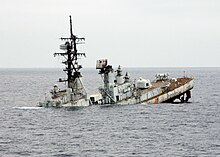USS Towers (DDG-9)
 The Towers in August 1982 |
|
| Overview | |
|---|---|
| Order | March 28, 1957 |
| Keel laying | April 1, 1958 |
| Launch | April 23, 1959 |
| 1. Period of service |
|
| Commissioning | June 6, 1961 |
| Decommissioning | October 1, 1990 |
| Whereabouts | Sunk in 2002 as a target ship |
| Technical specifications | |
| displacement |
3,277 tons |
| length |
133 meters |
| width |
14 meters |
| Draft |
4.6 meters |
| crew |
354 |
| drive |
2 propellers, driven by 2 steam turbines; 70,000 hp |
| speed |
33 knots |
| Armament |
|
The USS Towers (DDG-9) was a destroyer commissioned by the United States Navy in June 1961 . The ship, which belongs to the Charles F. Adams class , gained notoriety primarily through its use in the Vietnam War , for which it received four Battle Stars . The Towers remained in service until October 1990, was removed from the Naval Vessel Register in 1992 and sunk as a target ship off the coast of California in October 2002 .
history
The Towers was laid down at Todd Pacific Shipyards on April 1, 1958 and launched on April 23, 1959. The commissioning took place on June 6, 1961 under the command of Commander LD Cummins. The ship was named after the naval aviator and Admiral John Henry Towers .
After completing the test drives, the Towers made several trips to Australia , Japan , the Philippines and Thailand as part of the WestPac fleet . From 1963 it was also used for training missions off the coast of California.
On January 5, 1965, the ship left San Diego for a war mission to Vietnam . It became part of the United States Seventh Fleet and was stationed in both the Gulf of Tonkin and the South China Sea . The main task was to secure the so-called Yankee Station and the aircraft carriers anchored there .
During the Vietnam War, the Towers was involved in a variety of acts of war. For example, it was used for submarine hunting in January and February 1966 . It also provided fire support for American troops, attacked Viet Cong positions and was involved in the rescue of American soldiers from enemy lines on several occasions. The riskiest of these was on August 31, 1966, when a United States Navy aircraft was hit by enemy anti-aircraft guns and crashed. The pilot of the machine was able to jump off his parachute beforehand, but landed in Hải Phong and thus directly behind the enemy line. Due to the presence of the Towers and the USS King (DDG-41) near the port, the pilot was rescued in time by an on-board helicopter of the King .
The use of the Towers in Vietnam lasted seven years until 1972, with interruptions for shipyard stays. For its merits, the ship received a total of four Battle Stars , its crew the Navy Unit Commendation .
After the Vietnam War, the towers were mainly used for training missions in the Pacific and made trips to several foreign ports, including in July 1977 for the annual Sea Festival in Vancouver .
Since November 1980 the ship was stationed in Yokosuka . It also took part in operations by the Japanese Maritime Self-Defense Forces . From October to November 1983, the Towers participated in the recovery of debris from Korean Air Lines Flight 007 , which crashed in September .
The ship experienced one of its last missions from August to November 1989 when it was patrolling the Persian Gulf . On October 1, 1990, the Towers was decommissioned and relocated to the reserve fleet . On May 27, 1992, it was removed from the Naval Vessel Register. On October 9, 2002, she was sunk off the coast of California as a target ship by the USS Sides (FFG-14) during a training mission .
A gig used by the ship's captain is on display today in Freedom Park, Omaha .
literature
- Thomas Petri: Lightning from the Sky, Thunder from the Sea . AuthorHouse, Bloomington 2009, ISBN 978-1-4389-4596-5 .
Web links
- Entry on the Towers on navsource.org (English)
- Entry on the Towers on navysite.de (English)
